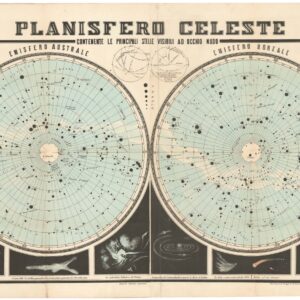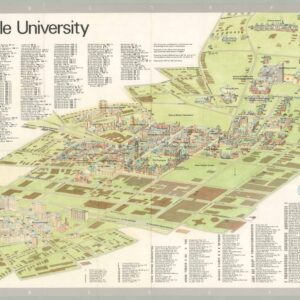Gerard de Jode’s Septem Planetae in pamphlet form with a gilded and rubricated manuscript title page.
Septem Planetæ Iconibus Elegantissimis. Ex: Pressæ.
$1,200
In stock
Description
Gerard de Jode’s Septem Planetae (Seven Planets) is a significant work within the history of cartography and early cosmology. The collection of prints was first published as part of a 1581 edition of De Jode’s monumental atlas, Speculum Orbis Terrarum. The plates depict the seven acknowledged planets of Antiquity: Sun, Moon, Mercury, Venus, Mars, Jupiter, and Saturn.
Neatline is pleased to present this group of extraordinary 16th-century prints in original pamphlet form. While the collection does not include the famous title page found in the version bound in the atlas, our pamphlet has a manuscript title page on which the words ‘Secundae Pars’ (second part) have been written in an elegant hand and then rubricated. Extraordinarily, both the title and rubrication have been gilded, reflecting a likely noble provenance.
The Septem Planetae is a striking representation of the Ptolemaic cosmological model, which dominated European thought for over a millennium. In this geocentric system, the Earth is positioned at the center of the universe, with the seven classical planets—Mercury, Venus, Mars, Jupiter, Saturn, the Sun, and the Moon—orbiting around it in concentric circles.
The plates were most likely engraved by the renowned Flemish engraver Adriaen Collaert. The ornate depictions reflect the Renaissance fascination with both the heavens and classical antiquity. Each figure is surrounded by rich allegorical imagery, showcasing the planets as gods and goddesses from Greco-Roman mythology. This artistic approach not only educated viewers about the prevailing scientific theories of the time but also connected them to the mythological and cultural heritage of antiquity.
As with De Jode’s maps, the Septem Planetae plates are today admired for their craftsmanship and for providing a window into Renaissance views of geography and astronomy. Both de Jode’s and Collaert’s work are recognized for their historical importance and aesthetic qualities, making original examples highly prized by collectors and institutions alike.
List of Plates
Mercurius
Venus
Jupiter
Sol
Mars
Luna
Saturnus
Cartographer(s):
Adriaen Collaert (c. 1560–1618) was a Flemish printmaker and engraver known for his detailed and precise works that contributed significantly to the flourishing print culture of the late 16th and early 17th centuries. Born in Antwerp, Collaert was part of a prominent family of engravers and publishers. He trained under his father, Jan Collaert I, and worked in the studio of Philip Galle, a leading print publisher. Collaert married Galle’s daughter, further cementing his ties to one of Antwerp’s most influential artistic circles.
Collaert’s work is characterized by its fine line work and meticulous attention to detail, often depicting religious, mythological, and naturalistic subjects. He produced engravings for various series, including works by well-known artists such as Maarten de Vos and Hans Bol. His prints were widely distributed across Europe, contributing to the spread of artistic and cultural ideas during the Renaissance. Collaert also played a crucial role in producing prints for the Galle publishing house, ensuring the studio maintained its reputation for high-quality works. His engravings remain highly regarded for their technical skill and artistic expression, making him a significant figure in the history of printmaking.
Gerard & Cornelis de JodeGerard de Jode (1511–91) was a Dutch printer and mapmaker born in Nijmegen but working from the metropolis of Antwerp. One of the most competent and reputable Dutch cartographers of the 16th century, he did not fare so well business-wise, as the competition was stark and his mercantile sense perhaps not so shrewd. In 1547, he was accepted into the Guild of St Luke’s in Antwerp and began working as a publisher and printer. De Jode quickly won recognition as an expert mapmaker in a city renowned for its cartographic output. His most outstanding achievement was a magnificent two-volume atlas titled Speculum Orbis Terrarum, published in 1578. The idea was to create an atlas that could compete with Abraham Ortelius’ hugely popular Theatrum Orbis Terrarum, published to great acclaim only eight years earlier. Despite De Jode’s status and reputation, his atlas was not a commercial success. The lack of circulation in 1578 has a lasting legacy today in that it is now one of the rarest and sought-after atlases, with only about a dozen copies known to exist.
Despite this lack of commercial success (or perhaps because of it), Gerard began working on a new and revised atlas. For this task, he recruited his son, Cornelis De Jode (1568-1600), as an assistant, and together, they compiled another innovative atlas titled Speculum Orbis Terrae, published in 1593. Sadly, Gerard de Jode died of old age less than two years before its publication, but perhaps he was spared the embarrassment of another commercial failure. Even though the new atlas contained both Gerard’s original maps, it also included several vital revisions and a range of entirely new maps compiled by Cornelis.
Like their 1578 predecessors, these 1593 maps are also scarce, especially since after Cornelius’ death, the engraving plates were sold to his competitor, J. B. Vrients (who also owned the Ortelius plates), who assured that the complete work would never be published again. Thus, while myriad editions of Ortelius were published and survive today, only the 1578 and 1593 form the legacy of the De Jode family.
Condition Description
Booklet is bound by thin thread. Minor restorations. Some pages more toned than others. See images for more detail. The engravings themselves are 11 x 15 cm (4.3 x 6 in).
References
![[Set of Four Allegorical Mezzotints of the Continents] America. Europa. Africa. Asia.](https://neatlinemaps.com/wp-content/uploads/2022/07/NL-01491-asia_thumbnail-scaled-300x300.jpg)


